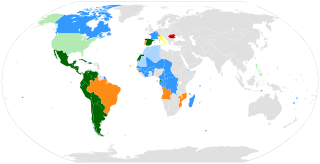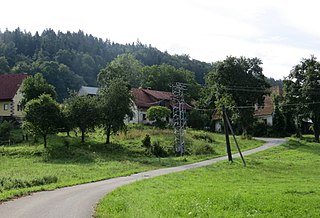
Adamovo is a small settlement in the Municipality of Velike Lašče in Slovenia. The area is part of the traditional region of Lower Carniola and is now included in the Central Slovenia Statistical Region.

Brankovo is a small settlement on the edge of the valley known as Mišja dolina, three km west of Velike Lašče in central Slovenia. The area is part of the traditional region of Lower Carniola and is now included in the Central Slovenia Statistical Region.

Brlog is a small remote settlement in the Municipality of Velike Lašče in Slovenia. A small part of the settlement lies in the neighbouring Municipality of Sodražica. The area is part of the traditional region of Lower Carniola and is now included in the Central Slovenia Statistical Region.

Gornje Retje is a small settlement in the Municipality of Velike Lašče in central Slovenia. The railway line from Ljubljana to Kočevje and the main road from Velike Lašče to Ribnica run through the settlement. The area is part of the traditional region of Lower Carniola and is now included in the Central Slovenia Statistical Region.

Hrustovo is a small settlement west of Velike Lašče in central Slovenia. The entire Municipality of Velike Lašče is part of the traditional region of Lower Carniola and is now included in the Central Slovenia Statistical Region.
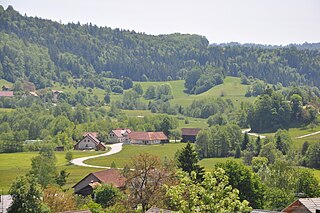
Kaplanovo is a small settlement west of Velike Lašče in central Slovenia. The entire Municipality of Velike Lašče is part of the traditional region of Lower Carniola. It is included in the Central Slovenia Statistical Region.

Karlovica is a settlement southwest of Velike Lašče in central Slovenia. The Velike Lašče area is part of the traditional region of Lower Carniola and is included in the Central Slovenia Statistical Region.
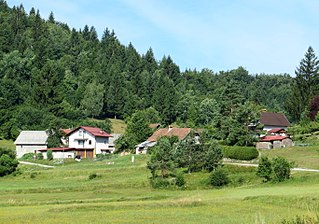
Krvava Peč is a village in the hills west of Velike Lašče in central Slovenia. The entire Municipality of Velike Lašče is part of the traditional region of Lower Carniola and is now included in the Central Slovenia Statistical Region.
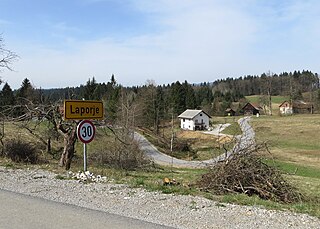
Laporje is a settlement southeast of Turjak in the Municipality of Velike Lašče in central Slovenia. It is included in the Central Slovenia Statistical Region. The area is part of the traditional region of Lower Carniola.

Lužarji is a small village in the hills southwest of Velike Lašče in central Slovenia. The entire Municipality of Velike Lašče is part of the traditional region of Lower Carniola and is now included in the Central Slovenia Statistical Region.
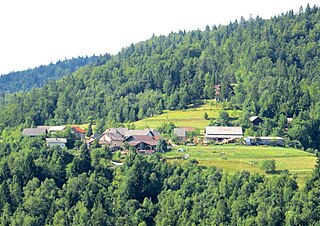
Mački is a small clustered settlement west of Velike Lašče in central Slovenia. The entire Municipality of Velike Lašče is part of the traditional region of Lower Carniola and is now included in the Central Slovenia Statistical Region.
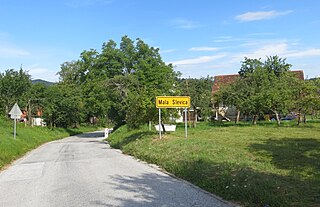
Mala Slevica is a settlement south of Velike Lašče in central Slovenia. The entire Municipality of Velike Lašče is part of the traditional region of Lower Carniola and is now included in the Central Slovenia Statistical Region.

Mali Ločnik is a settlement north of Turjak in the Municipality of Velike Lašče in central Slovenia. The entire Municipality of Velike Lašče is part of the traditional region of Lower Carniola and is now included in the Central Slovenia Statistical Region.

Plosovo is a small settlement at the southern end of the Mišja Valley southwest of Velike Lašče in central Slovenia. The entire Municipality of Velike Lašče is part of the traditional region of Lower Carniola and is now included in the Central Slovenia Statistical Region.

Polzelo is a small settlement on a small hill above the Mišja dolina valley southwest of Velike Lašče in central Slovenia. The entire Municipality of Velike Lašče is part of the traditional region of Lower Carniola and is now included in the Central Slovenia Statistical Region.

Poznikovo is a settlement on a small hill at the southern end of the Mišja Valley southwest of Velike Lašče in central Slovenia. The entire area around Velike Lašče is part of the traditional region of Lower Carniola and is now included in the Central Slovenia Statistical Region.

Srobotnik pri Velikih Laščah is a small village southeast of Velike Lašče in central Slovenia. The entire Municipality of Velike Lašče is part of the traditional region of Lower Carniola and is now included in the Central Slovenia Statistical Region.

Ščurki is a small settlement west of Turjak in the Municipality of Velike Lašče in central Slovenia. The entire Municipality of Velike Lašče is part of the traditional region of Lower Carniola and is now included in the Central Slovenia Statistical Region.





